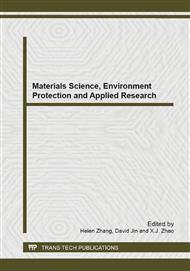[1]
Lee J W, Choi S P, Thiruvenkatacharl R, et al. Evaluation of the performance of adsorption and coagulation processes for the maximum removal of reactive dyes. Dyes Pigments, 196-203, (2006).
DOI: 10.1016/j.dyepig.2005.03.008
Google Scholar
[2]
Yuksel E, Gurbulak E, Eyvaz M, Decolorization of a reactive dye solution and treatment of a textile wastewater by electrocoagulation and chemical coagulation: Techno-economic comparison . Environmental Progress&Sustainable Energy, 31(4): 524-535, (2012).
DOI: 10.1002/ep.10574
Google Scholar
[3]
Korbathi B K, Tanyola A. Continuous electrochemical treatment of simulated industrial textile wastewater from industrial components in a tubular reactor. Journal Of Hazardous Materials. 2009, 170: 771-778.
DOI: 10.1016/j.jhazmat.2009.05.032
Google Scholar
[4]
Farabegoli G, Chiavola A, Rolle E, et al. Decolorization anaerobic-aerobic sequencing batch reactor. Biochemical Engineering Journal, 52: 220-226, (2010).
DOI: 10.1016/j.bej.2010.08.014
Google Scholar
[5]
Gao B Y, Wang Y, Yue Q Y, et al. Color removal form simulated dye water and actual textile wastewater using a composite coagulant prepared by ployferric chloride and poly dimethy ldially lammonium chloride. Separation and Purification Technology, 54: 157-163, (2007).
DOI: 10.1016/j.seppur.2006.08.026
Google Scholar
[6]
TANG Li Application and Research on Treating Wastewater ofPrinting and Dyeing by Coagulating. Journal Of Sichuan University Of Science & Engineering, 20(1): 79-81, (2007).
Google Scholar
[7]
DenteL S K. Coagulation Control in Water Treatment[J]. CRC Critical Reviews in Environmental Control, 21(1): 41, (1991).
Google Scholar
[8]
WANG Dai-zhi, The treatment of dyeing waste water by flocculation and fly ash. Textile Auxiliaries, 26(4): 32-34, (2009).
Google Scholar
[9]
Liu Yong. Study on the pretreatment of printing & dyeing wastewater with composite polyaluminum ferric flocculants. Industrial Water Treatment, 33(12): 25-28, (2013).
Google Scholar
[10]
Duk Jong Joo, et al. Decolorization of reactive dyes using inorganic coagulants and synthetic polyme. Dyes and Pigments 73: 59-64(2007).
DOI: 10.1016/j.dyepig.2005.10.011
Google Scholar
[11]
FENG Xiu-juan, ZHU Yi-chun, et al. Preparation of Rare-earth Residue Flocculants and Its Application to Treatment of Printing and Dyeing Wastewater. China Water & Wastewater (23): 95-98, (2008).
Google Scholar
[12]
LI Jun, HUANG Ling, Application of flocculant to wastewater treatment. Printing and Dyeing, (16)43-45, (2008).
Google Scholar
[13]
Zeng Xiaojun, Application studies of novel cationic flocculant KD-1 in the treatment of reactive printing and dyeing wastewater[J]. Techniques And Equipment For Environmental Pollution Control, 6(3): 72-74, (2005).
Google Scholar
[14]
Wan Tao, Feng Ling, Du Shi-yong, et al. Decoloration of printing wastewater by amphoteric polyacrylamide flocculant[J]. Technology Of Water Treatment, 31(9): 39-41, (2005).
Google Scholar
[15]
Wang Yuting Wan Lili. Applications of chitin. chitosan and its derivatives to water treatment. Pollution Control Technology, 13(1): 51-53, (2000).
Google Scholar
[16]
SONG Hui, MA Xi-chen. Synthesis and Application of Anion Inartificial High Molecular Flocculant (SAH). Leather Chemicals, 20(3): 17-21, (2004).
Google Scholar
[17]
Dai Ping, Gao Baoyu, Xu Pengju, et al. Decolorization of dyeing wastewater by using organic polymer BT-O2 and PAC as flocculants[J]. Industrial Water Treatment, 24(12): 40-42, (2004).
Google Scholar
[18]
ZHUANG Ya-feng, YAO Guo-sheng, LI Jie-li, Study on Decolorization of Dyeing Wastewater Using Magnesium Hydroxide-starch Complex Flocculant. Chemistry& Bioengineering, 24(2):29-31, (2007).
Google Scholar
[19]
LIU Guiping , ZHU Xing , WANG Mingjie, WANG Liduo, Application of inorganic-organic composite flocculant on dye wastewater treatment[J]. Journal of Textile Research, 34(4):98-103, (2013).
Google Scholar
[20]
TAN Wan-chun, et al. Treatment of dye wastewater by coagulation and Fenton. Journal Of Changsha University Of Science And Technology(Natural Science), 7(1): 87-92, (2010).
Google Scholar
[21]
Shen Yongjun, Wang Zhixin. Experimental Study on Treatment of Dyeing Wastewater with Ozone Pre-oxidation and Coagulation. Guangdong Chemical Industry, 38(10): 254-256, (2011).
Google Scholar
[22]
Qiu Xianhua, et al. Treatment of the dyeing wastewater by coagulation sedimentation and biological contact oxidation technolog. Industrial Water Treatment, 23(10): 71-73, (2003).
Google Scholar
[23]
LIU Jiu-qing, LIU Wan-rong, JIANG Bin, Dyeing and printing wastewater treatment by combined coagulation-MBR technology. Journal Of Central South University Science And Technology, 40(6): 1488-1493, (2009).
Google Scholar
[24]
Ren Jian, Pilot study on treatment of strong acid dyeing wastewater with ferric/carbon microelectrolysis-coagulation sedimentation-biological process. Techniques and Equipment for Environmental Pollution Control, 05(9): 1999-2004, (2011).
Google Scholar
[25]
XU Yu dong . Treatment of towel printing and dyeing wastewater using process of biochemical coagulating preci pitation-sand filter [J]. Environmental Science And Technology (2): 39-41, (2000).
Google Scholar


